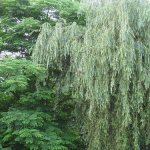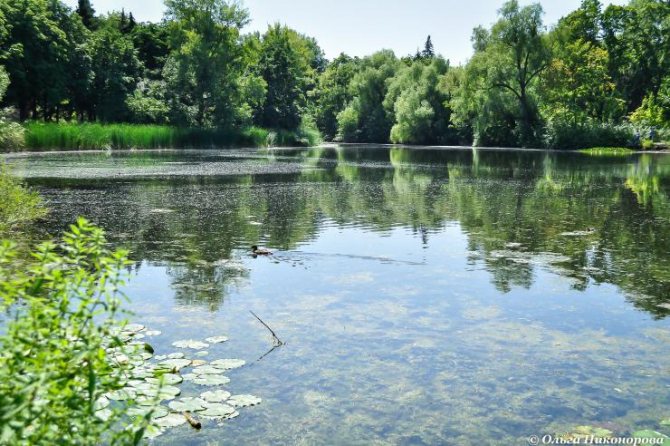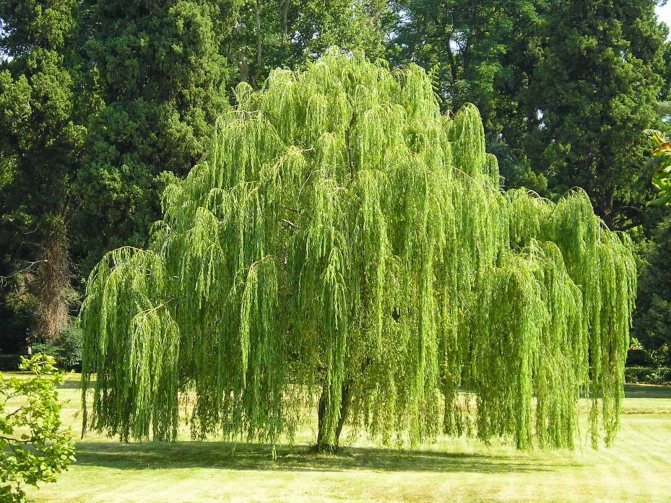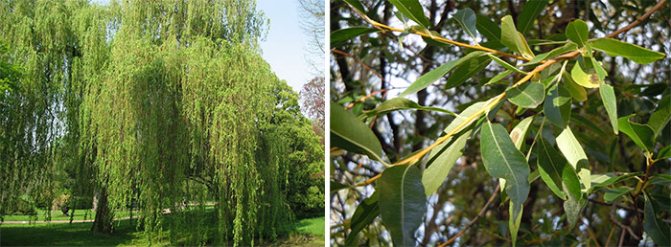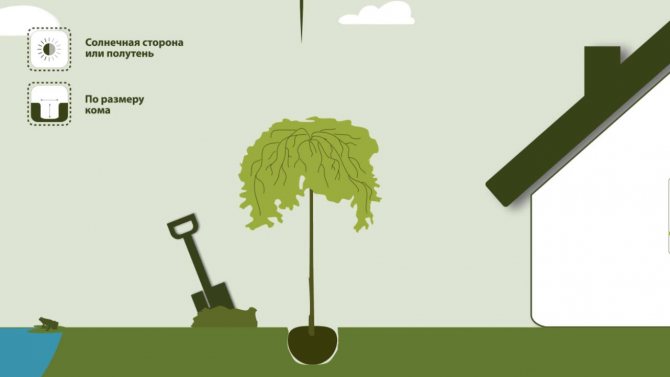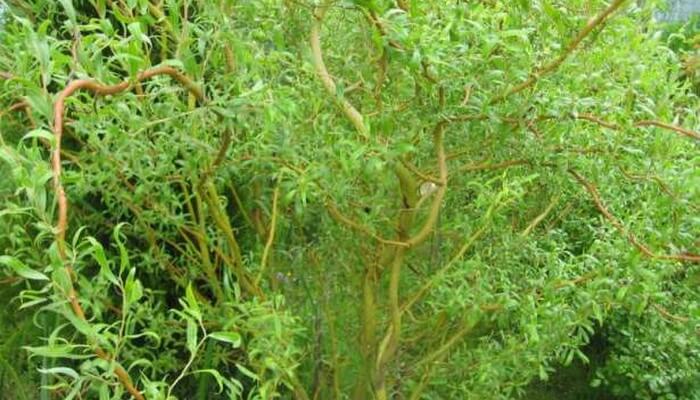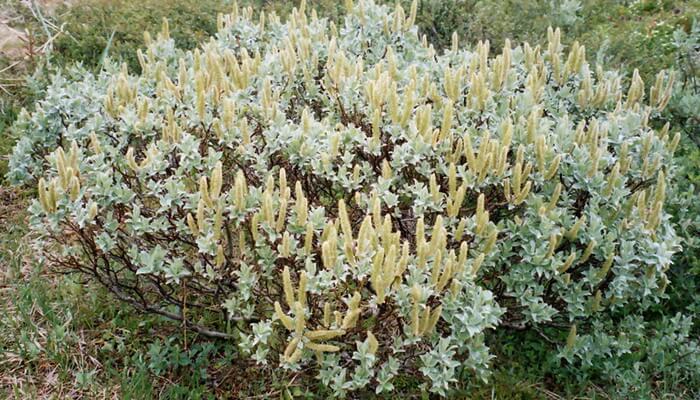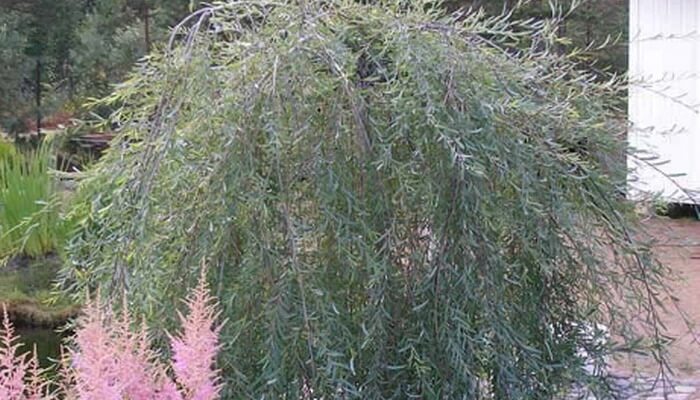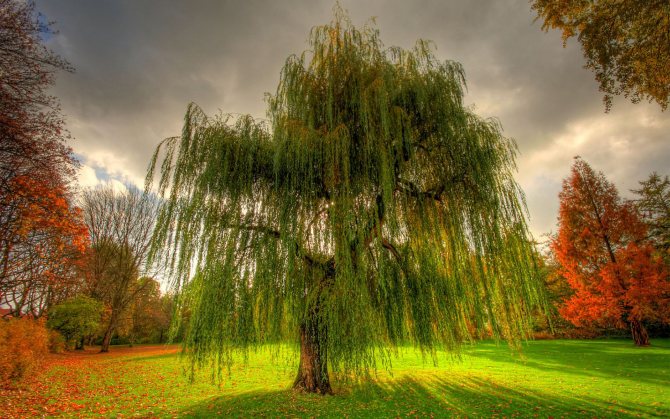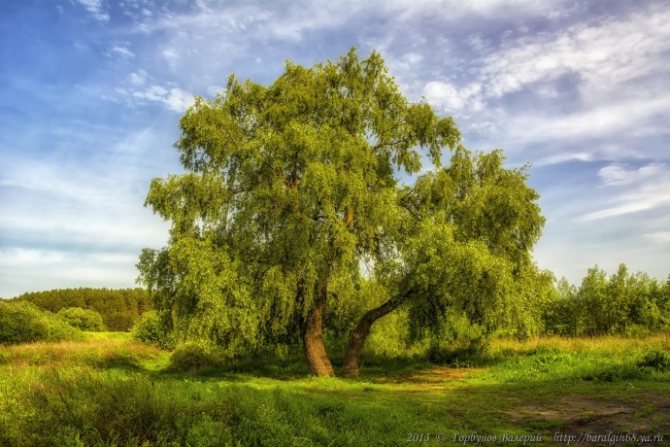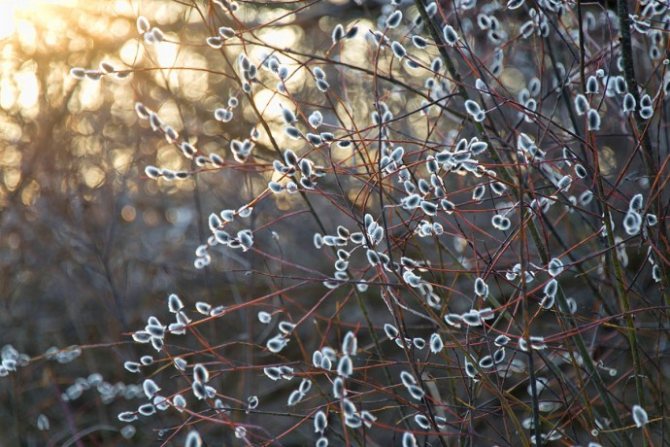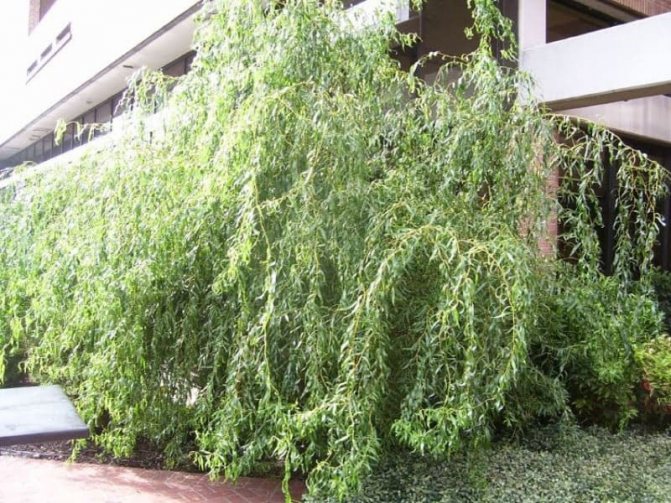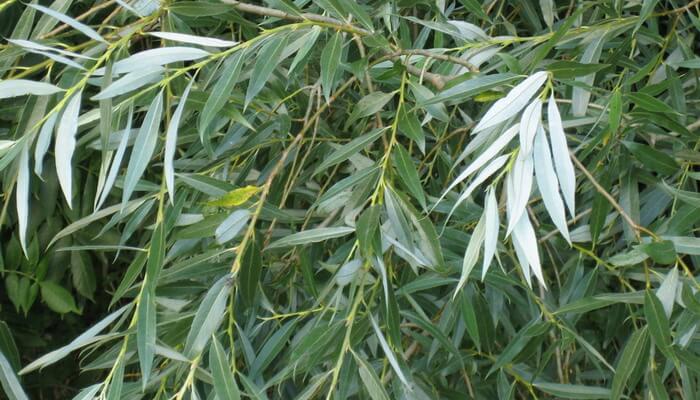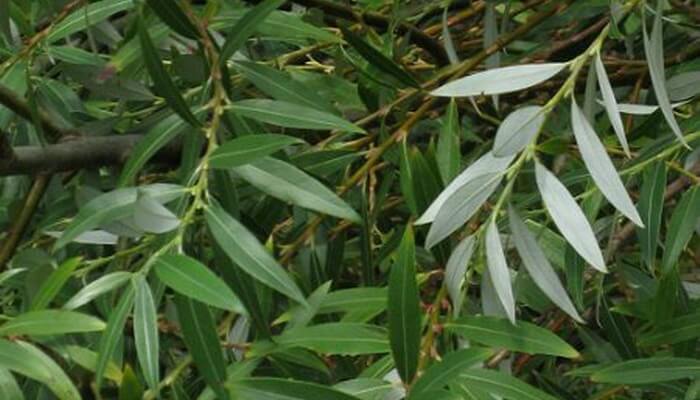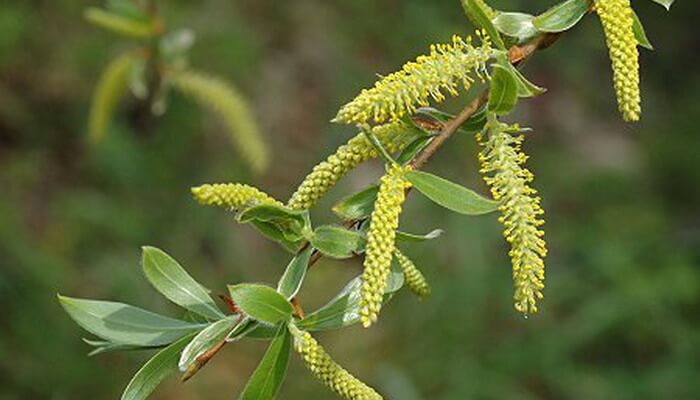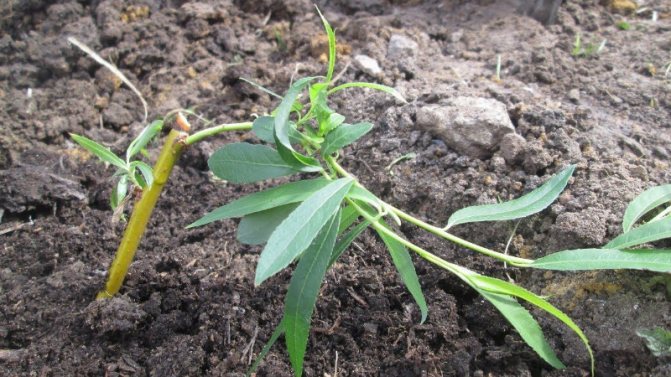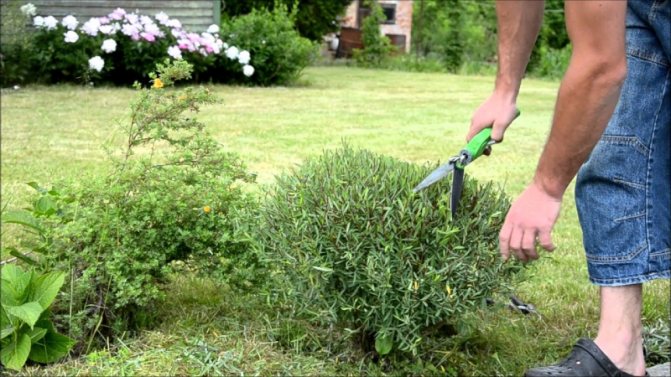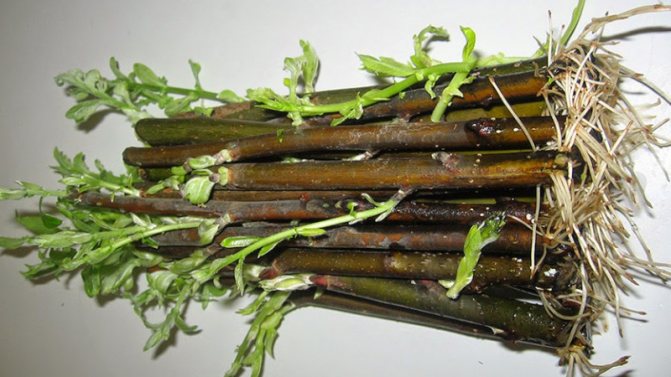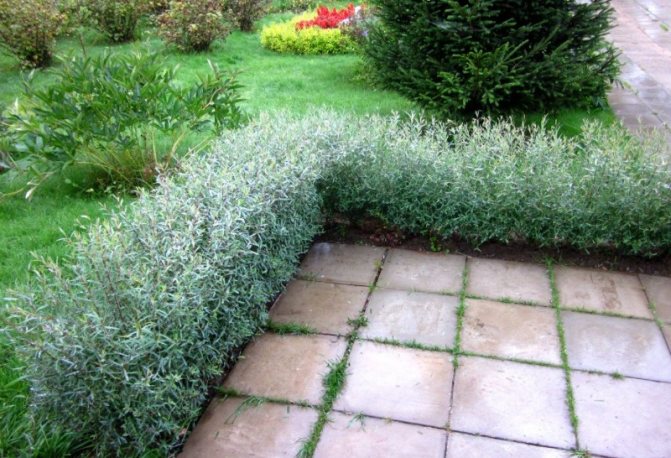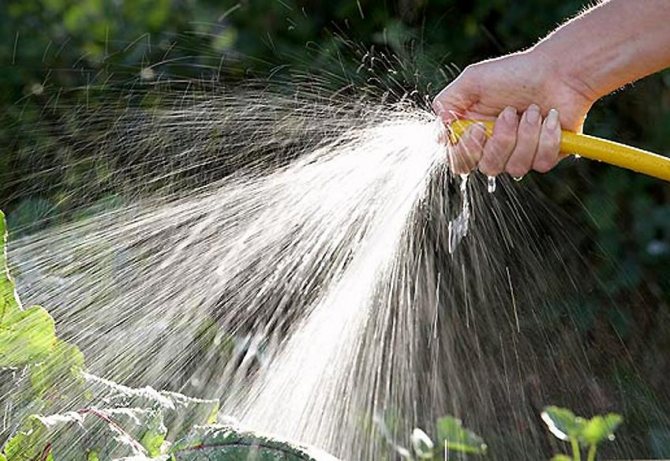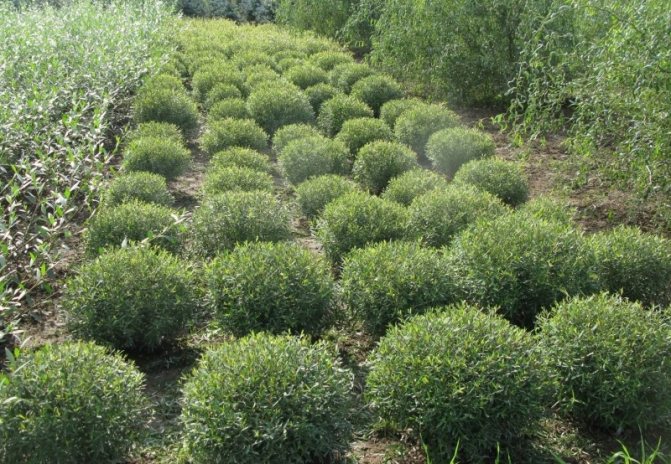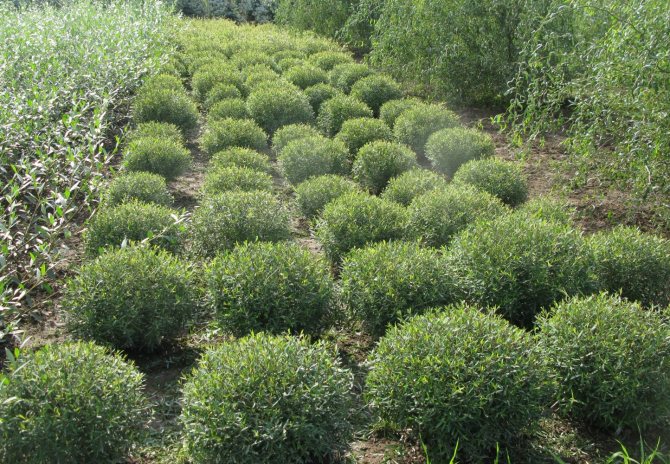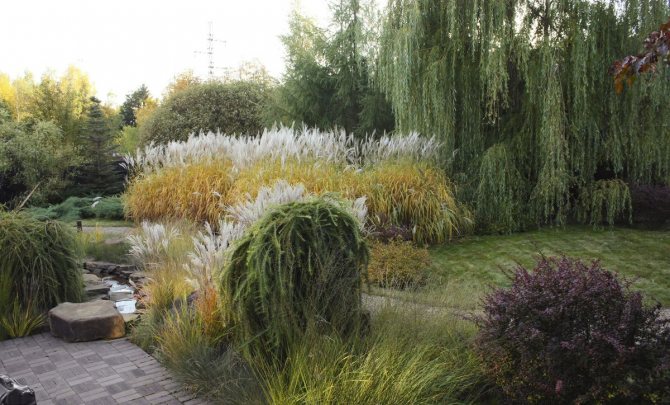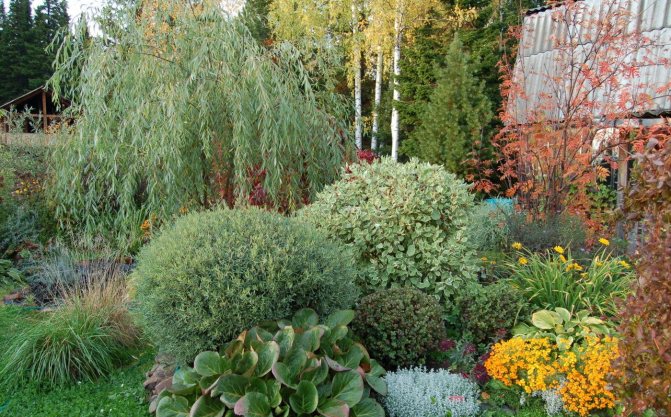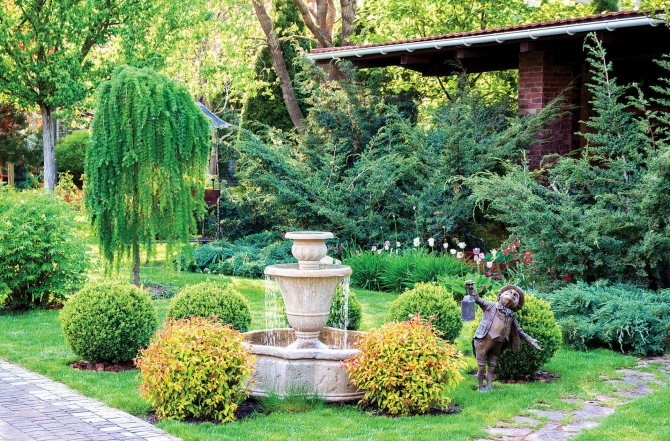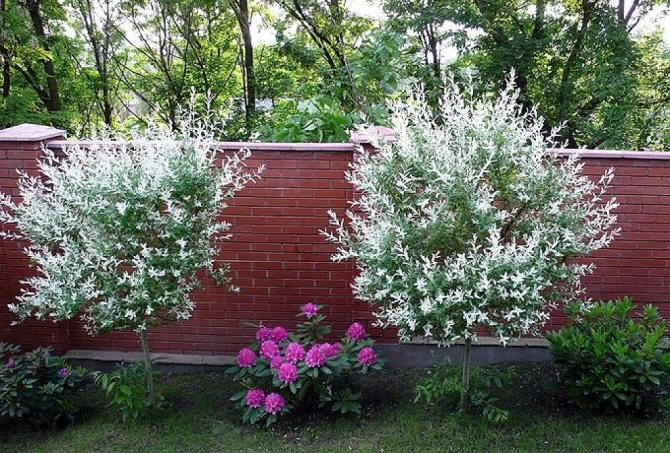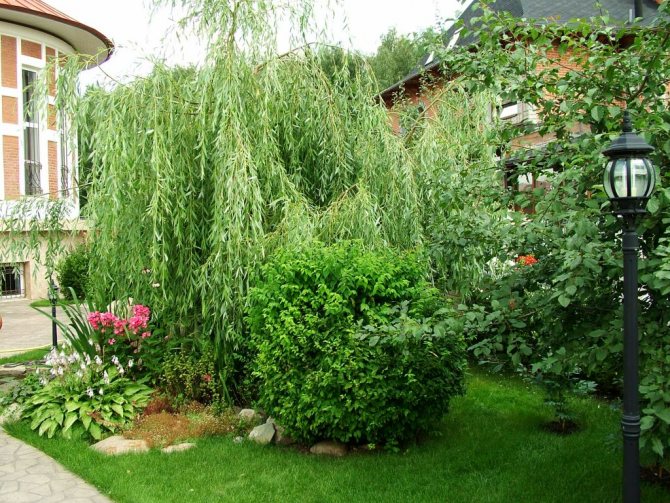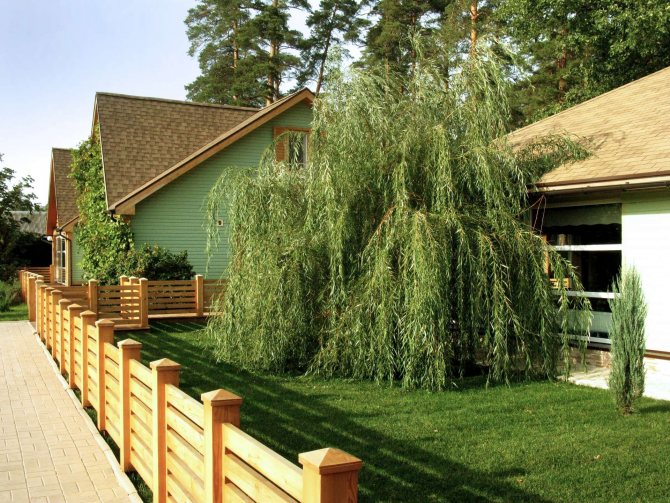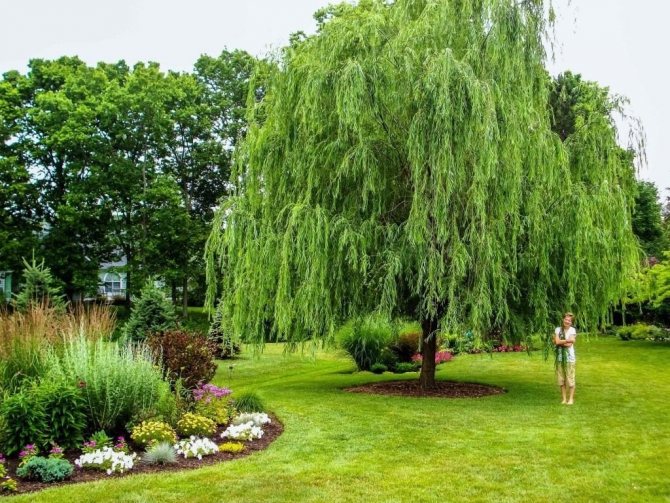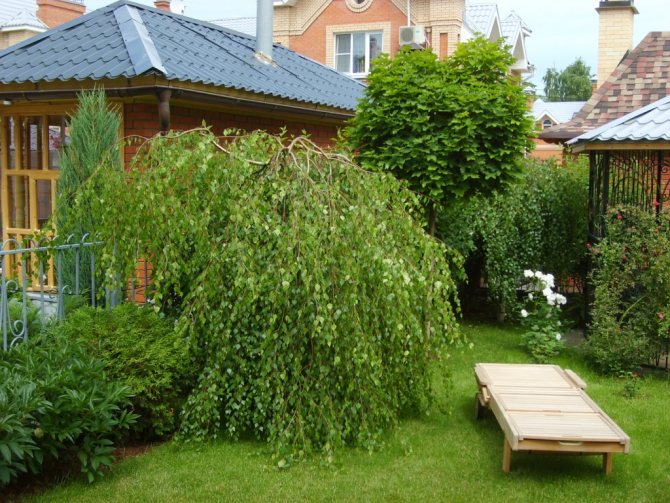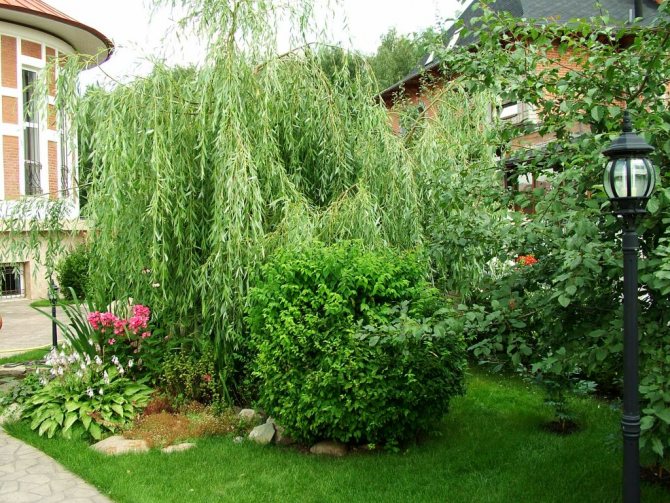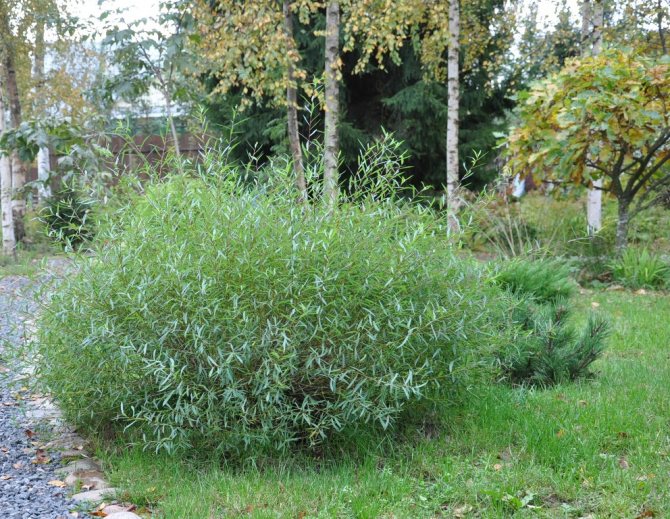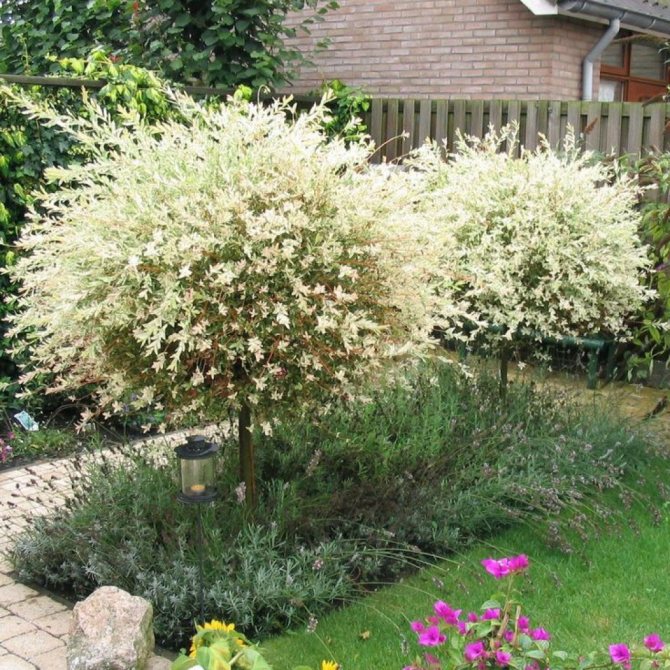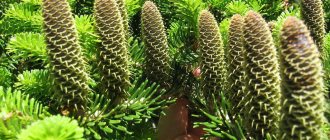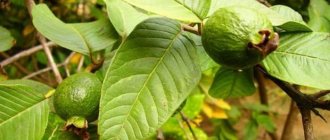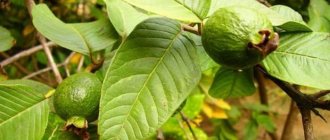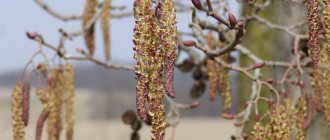Willow is considered one of the oldest trees on the planet. Siberia and Central Asia are considered the birthplace of willow, but it also grows in the United States. This beautiful tree is widespread in northern and temperate latitudes, although it sometimes grows in subtropical regions.
The tree has many varieties. Below are the most basic and common types of willow:
- rod-shaped;
- purple;
- goat;
- weeping;
- spherical;
- dwarf;
- five-chained;
- American;
- wavy-leaved;
- Russian;
- holly.
Now about each tree in order.
Willow
This type of willow is considered one of the most common. It is a shrub with many branches, reaching up to about 5 meters. The bark is purple in color with a bluish bloom. The buds are brown. The earrings open up almost on a par with the leaves. It grows in the middle zone of the country.
For planting, it is better to choose frost-resistant plants so that they do not freeze in winter. Therefore, before laying the hedge, you should first mark the territory. You need to dig a hole with a diameter of 50 centimeters and the same depth. If the soil is rough, it is worth adding sand to it. It should be planted at intervals of 20 centimeters. After planting, the plant must be watered frequently.
Tree care
Types of tree care
| Care | Description |
| Watering | In summer and during hot weather, the willow requires abundant watering. If the species is dwarf, then it is recommended to spray the crown itself in the heat. Watering the weeping willow in the summer is necessary daily. In winter, you can limit yourself to one watering per week. |
| Top dressing | You need to feed the plant only at first and immediately after planting in the ground (and even then, this is optional). In good soil, willow will grow without additional fertilization. |
| Pruning | Not all willows can be pruned due to their height. But, if you nevertheless decided to prune the willow, then this should be done in the spring. Timely pruning not only improves the appearance, but also has a positive effect on the health of the tree. |
Purple
In purple willow, the leaves are divided into alternate and opposite ones, up to 12 cm long. They grow upward and are pointed. Most often, this type of tree can be found in the southern and middle zone of the country, and in the mountainous areas of the Urals and Crimea. It can also be found in America, Asia and Africa. The tree is light-loving, but it does not tolerate groundwater and flooded areas. It is perfectly cleaned from the bark. It is valued for being slightly branched.
Determining where to plant a purple willow is not difficult: you need to choose a place with constant access to light. This tree loves moisture, so you will have to get an automatic watering of the grass. This willow differs from others in that it is not whimsical to the soil. It is worth planting in early spring.
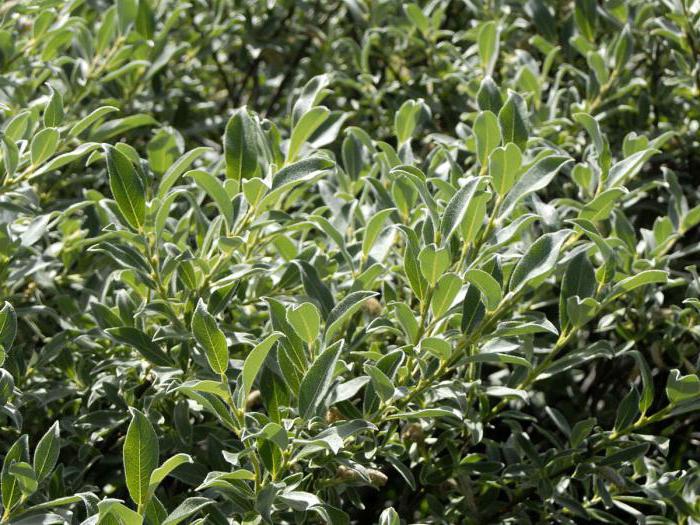
Use in landscape design
Weeping willow can decorate any garden or vegetable garden, which has a small river or artificial pond. Wood looks great next to water and that's why landscape designers use it for this purpose.
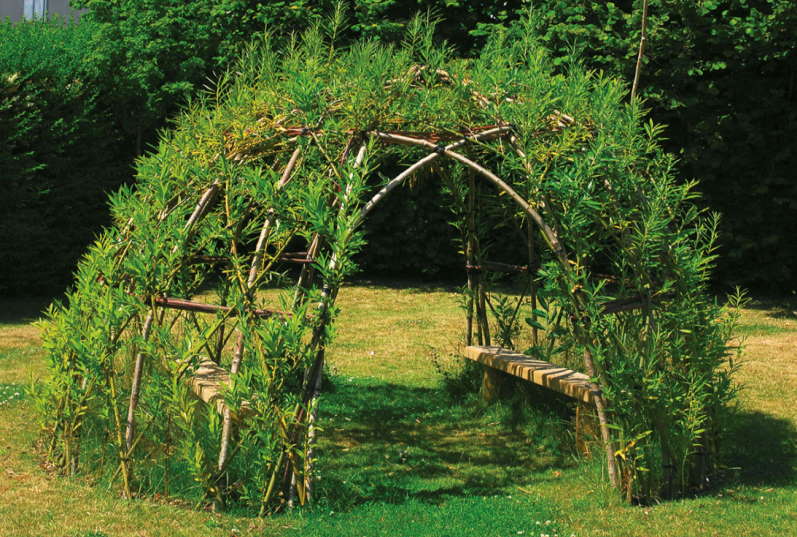

An excellent decoration, not only in the garden, but also at home, can be decorative and dwarf species of weeping willow.
Weeping willow is a powerful tree that fits into any design and not only enchants with its beauty, but also creates all favorable conditions for comfortable living and growing new plants.
Goat
Goat willow is a versatile landscaping species. It grows up to 10 meters high. Has a smooth green-gray bark. The branches of the plant are dense and spreading. The leaves are oval serrated with a green top and a light gray fluffy bottom. Such a tree grows in the European part of the country and Asia Minor. The habitat is non-swampy soil or forest edges.
In the steppe zone, it can be found next to forest valleys.
It is better to plant goat willow in early spring, when it will have optimal conditions to get used to the place and gain root mass. The tree will need to be watered frequently at first. In drought, it is better to do this more often. In the second year of growth, it can be watered once a week.
Application
Willow looks great in solitary and group plantings. For the design of rockeries and rock gardens, dwarf species of this shrub are often used. Most varieties withstand pruning very well and are used very often. for the manufacture of hedges.
Related article: Pinia description and features
Most often, willow is found next to water bodies, where they look especially impressive due to the silvery-green shade of the leaves, successfully complementing the water surface. A big plus of these plants is a powerful root system, which allows them to be used to strengthen slopes and prevent soil erosion.
Weeping
Weeping willow grows to a large size. Her bark is yellowish. Leaves are green. The branches are down. The habitat of this tree is reservoirs in central Russia.
This plant should be planted in sandy soil and fertilized with compost. From cuttings, the tree grows faster. Planting weeping willow is best done in late autumn. Shoots should be chosen those that are at least two years old. The cuttings must first grow in a home greenhouse, and when spring comes, they need to be transplanted to an area where holes of a certain size are dug, about 50 centimeters. The soil should be loosened and fertilized. Do not forget to water and care for the plant frequently.
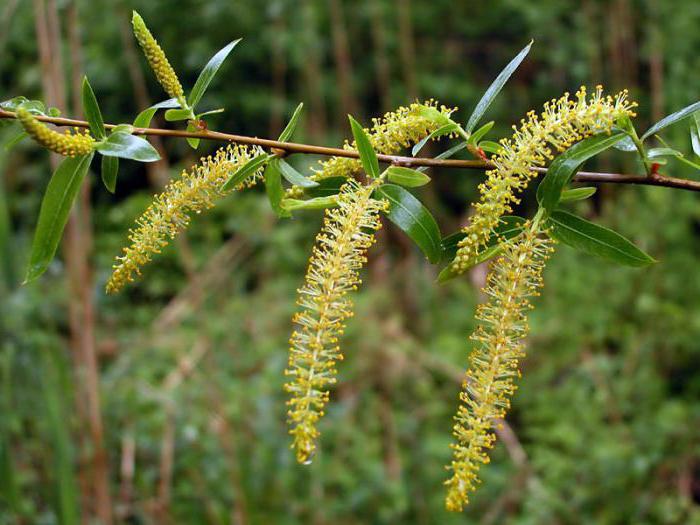

Planting and care rules
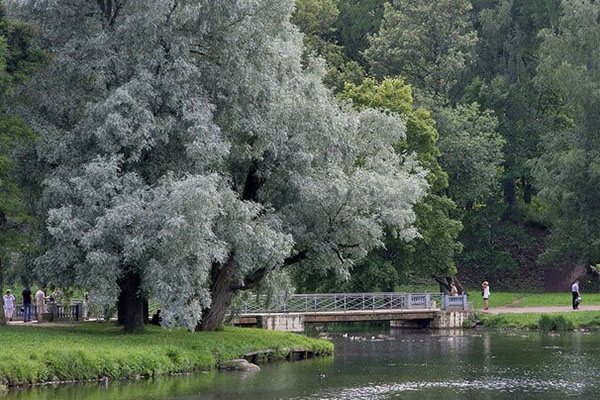

It is not difficult to care for the decorative weeping willow. The only thing worth paying attention to is the composition of the soil and its moisture content. Under natural conditions, the tree grows on sandy loam or loamy soils and constantly receives the required amount of water from the reservoir. If you plant willow far from natural sources of moisture (pond or river), it will have to be constantly watered. On dry, sultry summer days, it will be helpful to spray the leaves.
The plant does not need additional feeding. It perfectly adapts to temperature changes and tolerates both heat and frost. However, you can periodically fertilize the soil with organic fertilizers - humus or compost.
Weeping willow is most comfortable to grow on constantly wet soil. It will grow faster if the groundwater level at the site is high.
Willow propagation
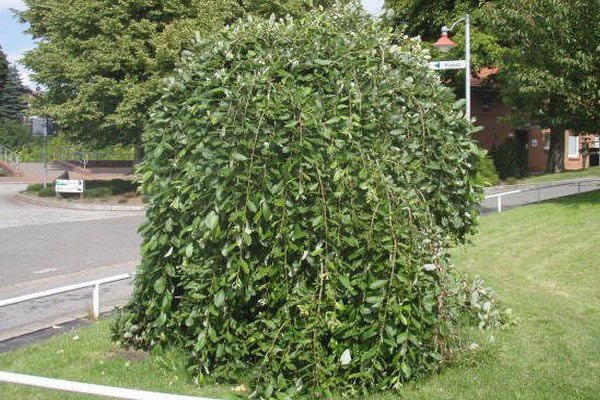

Under natural conditions, the tree propagates by seeds, cuttings or seedlings are used at home. Cuttings are harvested in spring or autumn; middle sections of young branches, which are no more than 2 years old, are suitable for them. Next, they need to be prepared for planting:
- the optimal cutting length is from 20 to 30 cm;
- planted in the ground in a greenhouse or any other warm room;
- until the seedlings get stronger and are not ready for transplanting, they need to be watered often, fertilized and loosened around the ground;
- young trees are not planted outside in the first year, they must spend the first winter warm.
Planting a weeping willow in open ground is carried out in the spring, when the snow has completely melted. By this time, the root system should already be fully formed in the young tree. You can also plant it in the fall, when the period of juice movement has already ended.In this case, the soil will need to be covered with leaves or straw, and the tree itself with spruce branches.
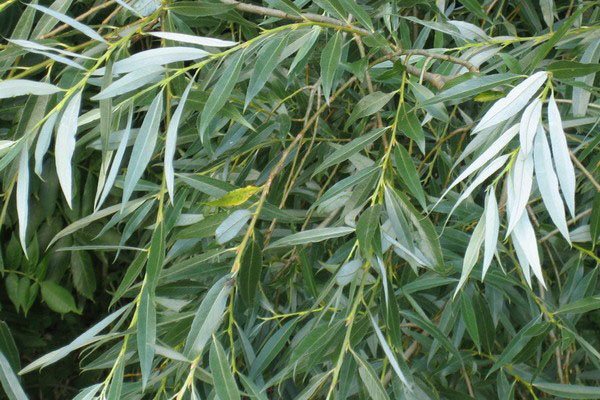

It is necessary to dig a shallow hole in the ground (up to 60 cm deep). During planting, the tree should be fertilized so that it takes root faster. The lower third of the pit is filled with a mixture of soil, peat and humus, and the remaining volume is filled with earth. The soil is raked to the seedling in such a way that it forms a mound, around which there will be a depression for irrigation. After planting, 2 buckets of water are poured under the plant. Dwarf weeping willow is no less resistant to changes in weather conditions than a full-fledged tree.
If the seedling is tall and unstable, it will need additional support. A peg is placed next to it, and the young tree is loosely fixed with a rope.
Growing on a trunk
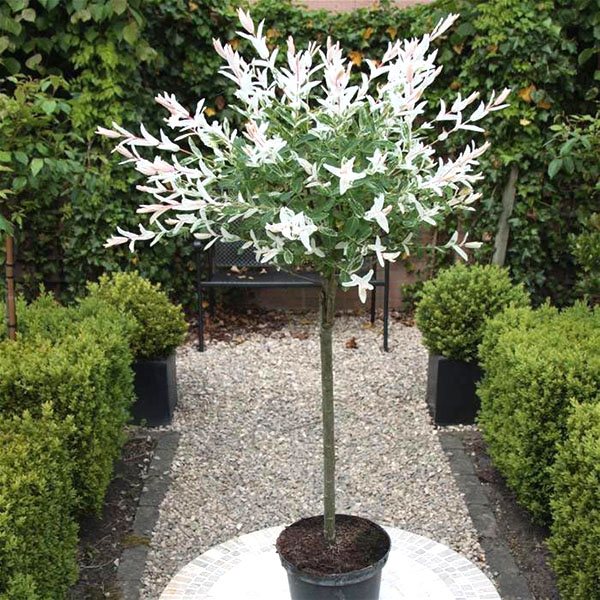

A weeping willow on a trunk will adorn any garden. Stamped trees are trees in which a decorative crown, own or grafted, departs from a straight trunk without branches (actually a trunk). For these purposes, a variety such as goat willow is suitable. It can be grafted onto a stem, but there is another way to grow it original:
- after planting, a strong and powerful shoot is chosen and tightly fixed to the support;
- as it grows, the trunk is tied up higher so that it grows straight and does not branch out;
- lateral shoots in the summer need to be shortened by a third, so that nutrients enter the main trunk, and it grows stronger;
- in the fall, the remaining parts of the shoots are removed completely, leaving hemp 0.5 cm long.
When the bole reaches the desired height, the support is removed. The next step is to form a uniform dense crown, which will fall down. To do this, it is enough to cut it in such a way that all the branches grow down. Their ends are pinched off, and the shoots begin to give new branches.
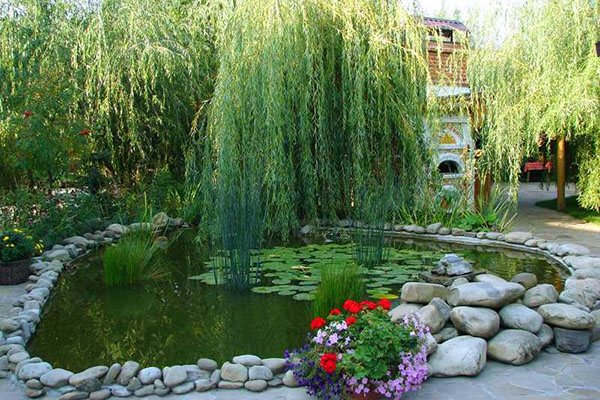

In the photo, a weeping willow grown on a trunk looks original. Other trees of upright varieties can be used as a headquarters, and goat willows can be grafted as a decorative crown. To begin with, you need to plant a stem so that by the time of vaccination it has time to get stronger and take root. The procedure is best done in late spring or early summer. When it is ready for grafting, a split is made at its top, into which a stock willow stalk is planted. They usually do well if vaccinated in the spring. As a result, the tree grows flat and tall from below, and a weeping crown is located at its top.
Before you plant a new tree in your garden, you should read the description of the weeping willow and make sure that the climatic conditions are right for it. It is not worth planting it in areas where the groundwater level is low, since you will have to water it daily. If possible, it is worth choosing places near natural or artificial reservoirs. Planting young trees is not difficult even for a novice gardener, but the preparation of the cuttings can be lengthy. The best solution would be to buy a young seedling ready for planting at the age of 1 or 2 years old, which already has a developed root system. With proper care and conditions, the tree will live at least 100 years.
Weeping willow in landscape design - video
Spherical
The spherical willow grows up to 20 meters and has many massive branches. In winter, the foliage of this plant changes from green to olive. The plant is attached to moisture, therefore it is found near the coast and dams. Cold resistant. The leaves are elongated and slightly rough. To keep the willow globular, it should be trimmed frequently. Globular willow grows in almost all parts of the country, but it is observed even in Australia, Africa and America. This tree lives up to 80 years.
It is worth planting it in April. The seedlings are usually bought from the nursery.When planting a willow tree, they dig a hole 30 centimeters deep and lower the seedlings there with lured soil in the form of peat and fertilizers. This will allow the plant to grow strong and healthy. The main thing is not to forget to regularly water the seedlings.
Dwarf
The dwarf willow has many varieties all over the world. It grows both in Europe and America. It is also found in mountainous regions. The tree is resistant to cold weather, but does not tolerate heat. Therefore, a comfortable weather for the living conditions of a dwarf willow will be a temperature of 25 degrees Celsius. The foliage of this plant is small and does not cause any particular problems during harvesting. The main advantage of this mini-type is that this tree reaches a height from one meter to two.
When planting willow, shoots are planted in soil lured with mineral fertilizers. In a drought, it is necessary to water the plant more often. Especially not whimsical to cold snap and can grow even in alkaline soils.
Now breeders are effectively breeding new dwarf willow varieties, and believe that they are the future.
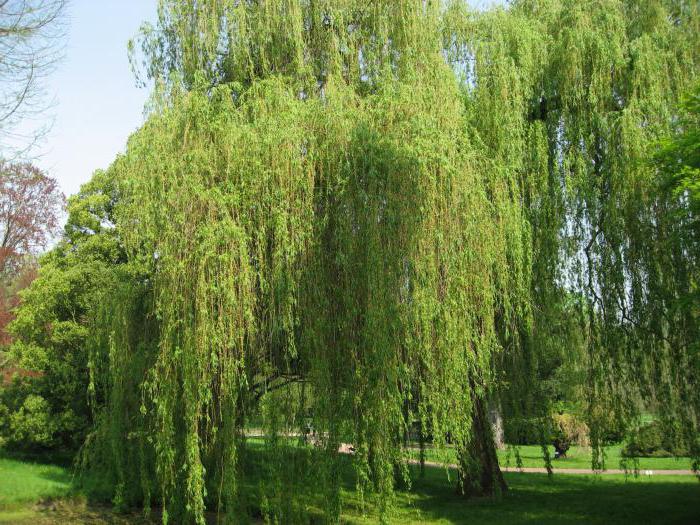

Varieties common in Russia
When talking about willow, the adjective "weeping" is often added, and many people think that this is a separate plant variety. In fact, this is a common characteristic of several varieties with a characteristic drooping crown. Many varieties of weeping willow are found in Russia.
Classic weeping variety, and its elongated silvery leaves in combination with long flexible branches create a spectacular lush crown that falls like a tent. The crown diameter can reach 20 meters in an adult plant. The undoubted advantages of this variety include unpretentiousness to soil and climate... Despite the fact that white willow can grow even in soil with excessive moisture, severe winters with sharp temperature changes will not destroy it.
However, in the warm season, the tree requires a lot of light and heat - then the tree will grow evenly, about 3 meters in five years. The maximum height of a willow tree of this variety is about 25 meters, and the width of the trunk is appropriate.
Flowering begins in mid or late spring, flowers have a yellow-green color, gather in tassels up to five centimeters. A common popular name for willow flowers is seals, for the fluffiness and tenderness of the inflorescences.
Babylonian
Another recognizable and popular variety of weeping willow. From the previous has a more elegant look... An adult tree reaches a height of about 12 meters, the crown spreads out in a similar diameter, and looks very delicate and graceful because of the thin flexible shoots flowing downward. The color of the leaves themselves can be green with a golden sheen or reddish. Such a tree can often be found in city parks, near water bodies.
The Babylonian willow has several other subspecies, which are quite different from each other in appearance, but they all require a lot of sunlight and abundant watering.
About this variety, we can safely say that it belongs to decorative - since this tree adds less in height than in the girth of a lush foliage cap. Leaves are of various shapes, their color ranges from rich green to grayish.
The main care for this variety is timely and correct watering... In wildlife, goat willow is found on forest edges, near roads and in ravines, that is, it does not need excessive watering and moisture, but it definitely loves water.
In order for the tree to delight with its beauty, fertilization will also be useful. The complex option is suitable for feeding in spring and autumn - twice a season will be enough.
So that the tree does not lose its aesthetic appeal, it is imperative you need to trim.
The mature tree is pruned after the flowering period is over. Active growth will ensure that all shoots are cut by a third or two-thirds of their length.
Alpine
Another variety, very beloved by landscape designers.The plant can hardly be called dwarf, but its maximum growth is 150-180 cm. A characteristic feature of the alpine willow is its early flowering - flowers appear earlier than leaves, and have a very interesting color. Depending on the subspecies of the shrub, the catkins on male trees can be orange, black, silver, and even red.
Like all willow trees, the variety loves moisture and abundant wateringas well as lots of sunshine. The decorative appearance requires mandatory pruning immediately after flowering ends, and this happens in April.
In addition to the fact that the alpine variety is used in landscape design (in alpine slides as well), it perfectly takes root in containers, decorating terraces and home "winter" gardens.
Whole-leaved
One of the most beautiful varieties of ornamental willow - prized for its variegated foliage and crown, which forms very quickly. It is in demand among gardeners and landscape designers.
Young shoots have a pale green tint, and mature leaves have an original color interspersed with white and pink. Under the scorching rays of the sun, variegated leaves can lose their brightness.
With correct and timely pruning, the crown will form at a slight distance from the ground, and will be about one and a half meters high. The crown of a plant, as a rule, is about a meter in diameter, but rarely exceeds a size of one and a half meters.
Like all her brethren, the whole-leaved willow cvetet, but only three years after thorough rooting... This stunted species prefers open sunny places, but it grows quite well in partial shade, where the sun's rays are scattered and warm the plant during part of the daylight hours.
Holly
Official name Easter willow, whose thin branches are dotted with touching fluffy lumps, sounds exactly like this. There will be at least three more accompanying names, but even without them, the willow is recognizable and loved by many since childhood, precisely because of this association with the bright holiday of Christ's Resurrection.
Geographically, this plant is found everywhere, since it is, perhaps, the most unpretentious in all species of willow. Sometimes the willow is specially planted along the river banks. Thus, the bank is strengthened, and the silting of the river disappears altogether. Separately, it should be noted that the plant is an excellent honey plant, and since it blooms as one of the first melliferous plants, it serves as a good food base for bees. And beekeepers actively use this.
Shaggy or woolly
This shrub species differs from its counterparts in the first place. frost resistance... Woolly willow grows successfully in the northern regions of Russia, Siberia, as well as in Scotland and Scandinavia.
Related article: Caucasian persimmon description and features
The tundra and forest-tundra habitat make plants creeping, stunted, and willow is no exception. The name, which speaks for itself, she got thanks to the shaggy, even a little felt, branches. At the same time, the leaves of the variety are of a dull, inexpressive color.
The branches, in addition to their "increased shaggy", are also characterized by nodularity and thickness.
This unpretentious, but effective in its own way used to form a hedge, or rather, its lower part, since the shaggy willow rarely exceeds 1 meter in height and, unlike other types of willow, does not tolerate an excess of moisture in the soil and a piercing cold wind.
Five-leaved willow
The five-stalked willow, a description of which will be presented below, works well in weaving. It grows in meadows and peat bogs in Siberia, as well as in European parts of the country, in particular in the lowlands. It can also be found in the Far East and in the Ural mountains. The tree reaches a height of over 10 meters. The bark of the plant is brown, and the shoots, leaves seem to shine in the sun.The willow leaves themselves resemble a laurel leaf, having an oval shape with denticles along the edges. In the upper part, the leaf is greenish, and below it is pale matte. Basically, such a tree is used for weaving furniture.
When planting in spring, it is necessary to moisten the ground with peat and compost and plant cuttings of the plant in the hole. Usually planted to a depth of forty centimeters between rows fifty centimeters wide. For this, the ground is pierced with a rod, and the plant is lowered in the place where the willow will grow. Then the soil is compacted. Cuttings are planted vertically and from south to north. This method is practiced by many gardeners.
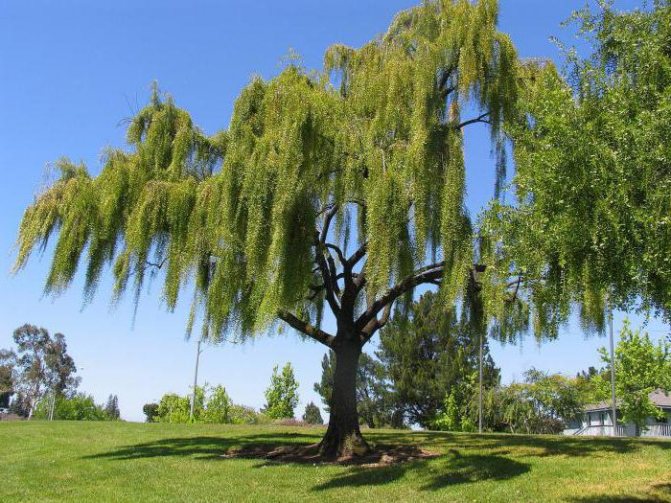

American willow
The American willow is considered the most cultivated in the forested areas of Russia. She is a hybrid of purple and five-stalked willow.
After the end of the growing season, the tilted end of the branch does not straighten. The leaves are narrow and elongated up to 15 centimeters. In the autumn, the bark has a purple hue with varying degrees of saturation. Below the vine is greenish. The advantage of this plant is that it retains its versatile qualities for willow crafts. It is widely distributed in the European regions of Russia.
A plant like the American willow should be planted in May. The cuttings are lowered into holes 30 centimeters deep vertically and from south to north and compact the earth. Here, like in the five-stalked willow, a metal rod is lowered into the soil. This method is practiced by many gardeners.
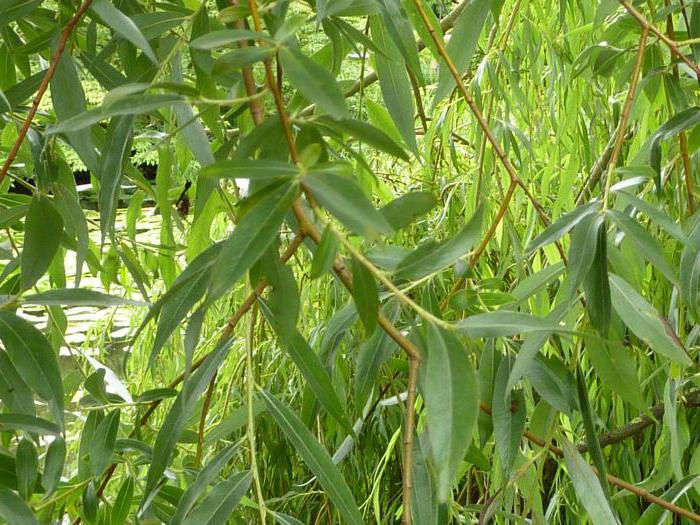

Wavy willow
The wavy willow is a cross between rod-shaped and five-stalked. It grows like a bush almost 5 meters high. The shoots of this plant are thin and flexible brown in color. The leaves are lanceolate, and the edges are serrated. The leaf blade has a wavy shape.
Young leaves are completely omitted, while adults are bare and slightly tilted downward. Almost always gives a one-year twig a little more than 2 meters in length, shades the soil, thereby contributing to the fight against overgrowth. The elasticity of the twig is the same as that of the five-headed willow. Perfectly cleaned of bark. The habitat of such a tree as the wavy-leaved willow is located near the coastal zone in the middle zone of the country, as well as in Europe.
To plant a willow tree, you need soil that contains loam. A place should be chosen such where sunlight will constantly enter. This tree will not grow in the shade. You can also use the location where the groundwater is located.
To properly plant this plant, you need to follow the following rules:
- dig a hole with a diameter of 50 centimeters and a depth of 30-40 centimeters;
- pour sand or crushed stone at the bottom of the pit;
- pour fertilizer from peat and soil;
- bury a hole in a third with earth and place a seedling there;
- tamp the soil into a pit to facilitate watering.
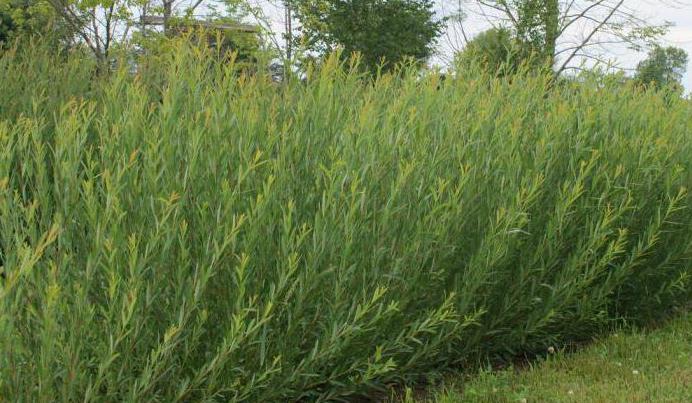

Botanical features
Willow belongs to shrubs and has more than 300 species. Some of them are successfully grown by gardeners on their plots. The plant has beneficial properties and is used in medicine, cosmetology, and various crafts. Due to its grace and extraordinary appearance, the tree has earned many poetic descriptions in literature and songs.
A feature inherent in weeping willow is a beautiful crown., which seems translucent from a distance. The branches are drooping, falling down vertically - this is what a willow tree looks like. The flowers are collected in inflorescences called catkins. Most species reach a height of 15 m, but there are also dwarf species that grow no higher than 2-3 m.In nature, there are giant willow specimens up to 40 m high.
In landscape design, the shrub is planted singly and together with other plants. Willow is not placed in groups, as it requires a lot of space. Dwarf varieties look great on alpine slides, and medium ones are planted along the site, forming a hedge. Mature plants are tolerant of pruning, and interesting curly compositions can be created from them.
If there is an artificial reservoir on the site, the willow will take its rightful place there, framing the stream or pond with its branches. In conditions of high humidity, the tree feels great, and at the same time creates a pleasant shade under which the owners of the garden can rest. Often the shrub is planted on the slopes to prevent further shedding. The willow has a powerful and branched root system that prevents the soil from crumbling.
Russian willow
Russian willow is considered less suitable for weaving. This tree reaches a maximum growth of 10 meters, and the shrub grows up to 6 meters in height. The branches are elongated, the color is gray-green. The leaves are narrow lanceolate in shape. The plant thrives most in Eastern Siberia and the Far East. It can be found along rivers and lakes, as well as near the banks. A rod of low quality and brittle is mainly used naked without bark.
This plant should be planted in May. The cuttings are lowered into holes 30 centimeters deep and compact the earth. As with the five-headed willow and the American willow, a metal rod is lowered into the soil. Cuttings are planted vertically and from southeast to northwest. This method is practiced by many gardeners.
Medicinal properties
In folk medicine, there are time-tested and mankind-tested means, the benefits of which are undeniable and which are used even in traditional medicine. Willow also belongs to them. Various parts of it, sometimes in combination with other plants, are used:
- with bleeding of gynecological origin
- as an antipyretic
- for malaria
- in case of violation of the sweat glands
- for skin diseases such as erysipelas, fungus, etc.
For medicinal purposes, mainly tree bark is used. Willow twigs are highly regarded for their flexibility among vine weavers.
Holly willow
Little products are made from holly willow. The plant itself reaches about 10 meters in height, and the bushes grow up to 5 meters. Has elongated thin shoots of a dark brown shade. The shape of the leaves is pointed, and at the edges it has denticles, on top - with shine, and below with a greenish tint. The European region of the country is recognized as the place of distribution of such a plant, and it is less common in Siberia and Central Asia.
This tree can be seen in coastal areas where it forms dense thickets. Resistant to frost and drought. It spreads more often than other willows in our country.
The rods of a tree such as holly willow are used to weave all kinds of furniture, except for baskets.
When planting a willow tree, it is necessary to prepare the site by freeing it from foreign objects. Then you need to dig grooves with a diameter of 30 centimeters and a depth of 40 centimeters. After that, plant the seedlings, sprinkling the soil with mineral fertilizers. Remember to water the willow, especially during the dry season.
Willow pest control
A tree like willow has many parasites that are ready to destroy the plant. Some of the main pests are:
- Alder weevil. Such a small insect makes moves in the bark of a tree, after which the leaves of the willow dry out and the wood of the twig deteriorates. The larva of such a parasite settle in branches and stumps, and often occurs in cracks in the tree bark. The only way to deal with it is to cut and burn the affected stems.
- Yellow leaf beetle. This is a bug that feeds on the foliage of trees. With a lot of larvae of this insect, the tree may die. They hibernate in fallen leaves and under bark. Therefore, one of the most effective methods of dealing with them will be just the destruction of the larvae of these beetles in winter. After the spring roasting of plants, fungal diseases are reduced.
- Aphids and spider moths gather in colonies on annual shoots and leaves, after which the plant turns yellow and becomes sick.
In addition to the above parasites, the willow tree has many different pests. The main thing is not to forget to take care of the trees in time and take preventive measures during the fight against insects.It is necessary to observe the light and water regime. Only with proper care and treatment from pests will a tree delight its owners for many years.
Diseases and pests
It is almost impossible to protect a tree growing in open ground from pests and diseases. Therefore, it is worth knowing in advance what problems you may encounter when growing and caring for a weeping willow, how to deal with pests and diseases.
The worst diseases include:
- white heart-shaped rot (affects the trunk from the inside);
- brown or black leaf spot;
- crown gall;
- powdery mildew;
- willow scab and so on.
In order to avoid attacks of pests and the development of various diseases, it is worthwhile to inspect the tree in a timely manner: remove dry leaves, process the near-stem arches, water only when necessary.
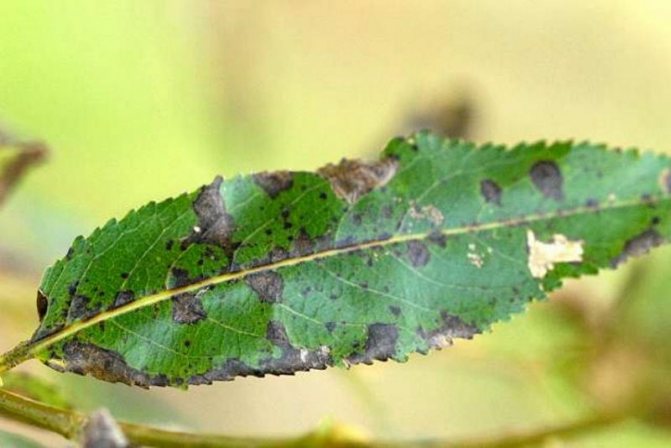

You can protect yourself from the attack of insects with the help of a special wood treatment, which you can buy in flower shops.

